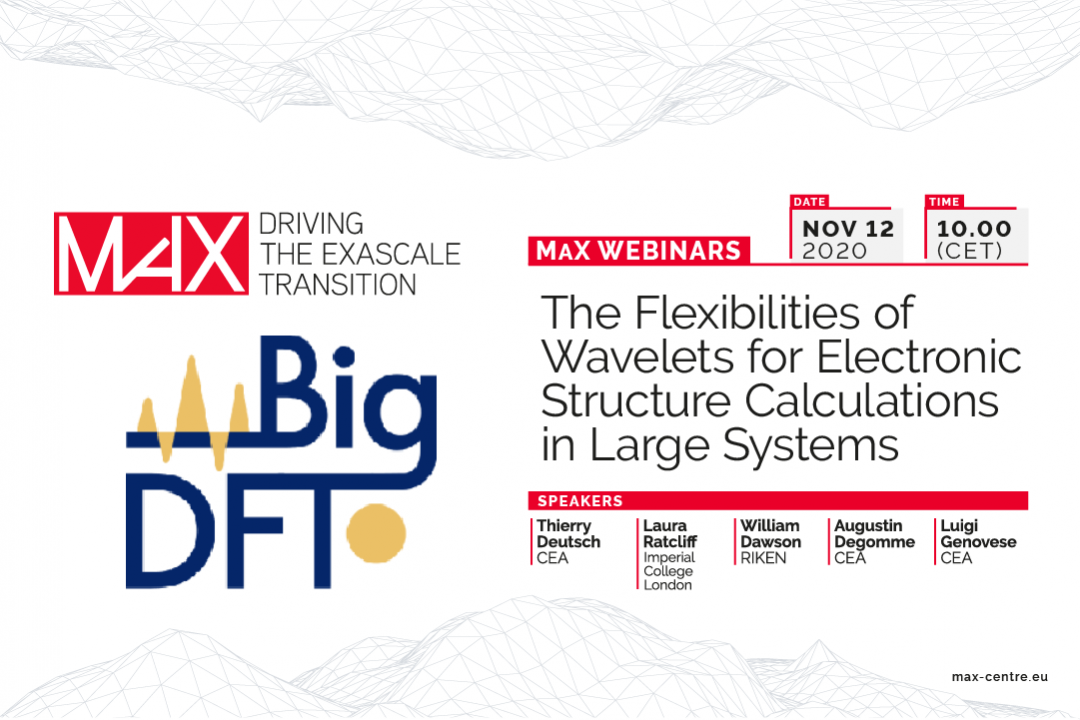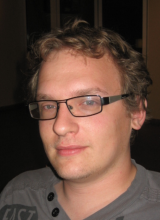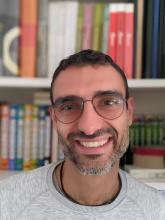
Thank you all those that joined us during the last series of MaX code webinars entitled "The Flexibilities of Wavelets for Electronic Structure Calculations in Large Systems", which took place on 12 November 2020, featuring teh BigDFT code.
Re-watch the webinar video recording below.
Presentations are available here, download a copy!
- Overview of the webinar topics - Luigi Genovese
- Motivations for BigDFT formalism: overview of Daubechies wavelets in DFT - Thierry Deutsch
- The operators of BigDFT code. From convolutions to Poisson Solver in High Performance Computing - Luigi Genovese
- Approach to Large Scale Systems with BigDFT: from Ground State to electronic excitations - Laura Ratcliff
- Complexity Reduction: how BigDFT basis set provides insights on electronic structure calculations of macromolecular systems - William Dawson
- Software approach of BigDFT: from modularization to containers. Aiida workflows with PyBigDFT - Augustin Degomme
- Concluding Remarks and Outlook - Luigi Genovese
Watch it again - If you missed anything or want to re-watch a session from our MaX code webinars, then the webinar recording is now available online, we introduced a special feature called "YouTube Chapters" in order to make the experience even more pleasurable (you can now skip with a click from a presentation to another).
Click here.
Description
The BigDFT project started in 2005 with the aim of testing the advantages of using a Daubechies wavelet basis set for Kohn–Sham DFT with pseudopotentials. This project led to the creation of the BigDFT code, which employs a computational approach with optimal features of flexibility, performance, and precision of the results. In particular, the employed formalism has enabled the implementation of an algorithm able to tackle DFT calculations of large systems, up to many thousands of atoms, with a computational effort that scales linearly with the number of atoms.
In this webinar, we will present some of the features that have been made possible by the peculiar properties of Daubechies wavelets. In particular, we focus our attention on the usage of DFT for large-scale systems. We show how the localized description of the KS problem, emerging from the features of the basis set, is helpful in providing a simplified description of large-scale electronic structure calculations. During the presentation, we will highlight how the MaX consortium enabled the possibility of the implementation of advanced functionalities in the context of pre-exascale computing.
Audience
Computational Physicists, Quantum chemists, Material Scientists. Anyone interested in the a uncommon usage of DFT calculations.
Agenda
10:00 - Overview of the webinar topics - Luigi Genovese
10:05 - Motivations for BigDFT formalism: overview of Daubechies wavelets in DFT - Thierry Deutsch
10:20 - The operators of BigDFT code. From convolutions to Poisson Solver in High Performance Computing - Luigi Genovese
10:35 - Approach to Large Scale Systems with BigDFT: from Ground State to electronic excitations - Laura Ratcliff
10:55 - Complexity Reduction: how BigDFT basis set provides insights on electronic structure calculations of macromolecular systems - William Dawson
11:10 - Software approach of BigDFT: from modularization to containers. Aiida workflows with PyBigDFT - Augustin Degomme
11:25 - Concluding Remarks and Outlook - Luigi Genovese
WEBINAR SPEAKERS
Thierry Deutsch
Thierry Deutsch is a CEA Research Director. He has a strong experience in new algorithms based on Density Functional Theory using real-space basis sets as Daubechies wavelets which permits order N techniques and large constrained DFT calculations on massively parallel supercomputers. He has coordinated the European project BigDFT where the eponym software package is the main outcome. He presently leads the Service of Materials Exploration and Modelling in CEA Grenoble.
Laura Ratcliff
Laura Ratcliff is an EPSRC Early Career Research Fellow in the Department of Materials at Imperial College London. She obtained an MPhys in Theoretical Physics from the University of York (2008), which included an Erasmus year at L’Université des Sciences et Technologies de Lille in France. She then undertook a PhD in the Department of Materials at Imperial College London (2012). She held postdoc positions at the Laboratory of Atomistic Simulation at CEA in Grenoble, France, followed by the Leadership Computing Facility at Argonne National Laboratory in the US. She returned to Imperial College early 2017, beginning her fellowship late 2017. Her research centres around the development of new methods for first principles materials modelling, with a focus on simulating large systems containing 1000s of atoms. She develops three density functional theory codes – BigDFT, ONETEP and MADNESS. Her interests lie in both the development of software for the efficient use of supercomputers and in applications to a diverse range of materials and properties.
William Dawson
William Dawson is currently a research scientist at the RIKEN Center for Computational Science in the Computational Molecular Science Research Team. He graduated from Grove City College in 2010, and the University of California Davis in 2016 with a doctorate in Computer Science. His main research interest is the development of software and algorithms for massively parallel electronic structure calculations.

Augustin Degomme
Augustin Degomme is a computer science engineer at the IRIG institute from CEA in Grenoble, working in the atomistic simulation team (L_Sim). He graduated from INSA Rennes in 2008 and previously worked for INRIA, CNRS, and University of Basel. His focus is on the development of high performance codes and the simulation of their behaviour on large HPC systems, mainly using the BigDFT code and the SimGrid simulation toolkit.

Luigi Genovese
Luigi Genovese is a CEA Researcher since 2010. He is a Computational Physicist in the domain of Material Sciences, with an education in Theoretical High Energy Physics. His research interests are related to the conception, development, and implementation of new theoretical algorithms and methods exploiting advanced computing resources, enabling large-scale computation in diverse areas in Material Science, Quantum Chemistry, and Electronic Structure calculations. He is maintainer of the BigDFT code. He is presently head of the Atomistic Simulation Laboratory in CEA Grenoble.

